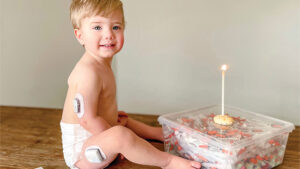For Myles Murphy, the signs all started rather suddenly. At 10 months old, he woke up one morning having trouble breathing and covered in urine. His mother, Ashley, rushed him to the emergency room, but test after test revealed nothing. He soon became lethargic, rapidly deteriorating.
Then it finally clicked when they checked his blood sugar: Miles was experiencing diabetic ketoacidosis, a serious issue that arises when the body produces high levels of ketones (blood acids) because it isn’t producing enough insulin. “His body was literally starting to shut down,” Murphy says. “Before that, I didn’t even known babies could have Type 1 diabetes.”
It’s a common misconception by many. Type 1 diabetes, also known as juvenile diabetes or insulin-dependent diabetes, can not only occur in children, but it’s not that uncommon. Type 1 diabetes occurs when the body does not produce insulin, a critical hormone required to live.
The American Diabetes Association reports that in 2014-2015, the yearly incidence of Type 1 diabetes in kids under the age of 20 was approximately 18,200. According to the Centers for Disease Control and Prevention, the rate of new cases of Type 1 diabetes in kids under the age of 20 increased by 1.9 percent per year between 2002 and 2015.
Symptoms of Type 1 diabetes are rather common – increased thirst, frequent urination, fatigue and weight loss, among others – and they can come on quite quickly. If a child exhibits any of these symptoms, it’s recommended to take the child to the pediatrician to have their blood sugar checked – or straight to the emergency room if the child’s symptoms seem to be worsening or highly progressed, says Dr. Giovanna Beauchamp, who works in Children’s of Alabama’s endocrinology department.
“Type 1 diabetes can be diagnosed with a simple blood test,” she says. “It’s best to also have a hemoglobin (A1C) test performed as well, which will provide information about the child’s average blood sugar level over the past three months.”
While there is no cure, it can be managed with a standard treatment: insulin. “Insulin is the mainstay of therapy, and it can be given in a number of different ways,” Beauchamp adds. “Diagnosis, however, does require for a child’s blood sugar level to be checked multiple times per day, and there are multiple ways of doing that as well.”
Symptoms of Type 1 diabetes are rather common – increased thirst, frequent urination, fatigue and weight loss, among others – and they can come on quite quickly.
Once diagnosed, the child’s blood sugar level will need to be checked multiple times a day to ensure it stays in the target range, and that can be done through continuous glucose monitoring devices – which actually check blood sugar every few minute – or a glucometer, which requires a finger prick to get a drop of blood. “Thankfully, the technology for Type 1 diabetes has evolved over the decades,” says Beauchamp, who lives with Type 1 diabetes herself as she was diagnosed as a child. “Unfortunately, it has developed because there is such a need for it.”
When treatment starts, like Beauchamp notes, there are a number of different ways a child can receive the needed insulin. Insulin can be given through multiple injections each day – whether it be in a needle and syringe like you typically see at a doctor’s office or via an insulin pen – or it can be delivered through an insulin pump, which delivers insulin to the body continuously throughout the day. “We do our very best to make diabetes as manageable as possible,” Beauchamp says. “It shouldn’t limit a child in doing anything they want to do in their lives.”

That’s been the case thus far for college student Olivia Webb, who was diagnosed at the age of four with Type 1 diabetes. She began exhibiting those classic symptoms, and her mother, Courtney, took her into the pediatrician’s office where she was diagnosed. “It was, of course, very scary when we first came home,” Courtney Webb says. “It can be incredibly overwhelming, there’s so much you have to start thinking about and paying attention to that you just never did before, but it turned out to be all right. They taught us really well at Children’s of Alabama on how to manage it.”
Managing insulin levels for another person – in particular a young child – can be quite difficult, Murphy notes. “Acting as a pancreas for someone else never pauses, never stops, and requires constant decisions,” she says. “There is constant worry of making a mistake.”
Myles wears a continuous glucose monitor, which updates with readings every five minutes, but to best protect him, Murphy also raised funds to purchase a diabetic alert dog, which is specifically trained to smell chemical changes that happen in the body when blood sugar increases or decreases. The family will receive the dog this summer.
“It’s another layer of protection,” she says. “So if the monitor isn’t working properly or we somehow sleep through the monitor’s alarm, the dog will ensure we take action. That peace of mind is incredibly important to our family because so much can impact your blood sugar.”
Paige Townley is a Birmingham freelance writer.





